June 17, 2025 | 18:07 GMT +7
June 17, 2025 | 18:07 GMT +7
Hotline: 0913.378.918
June 17, 2025 | 18:07 GMT +7
Hotline: 0913.378.918
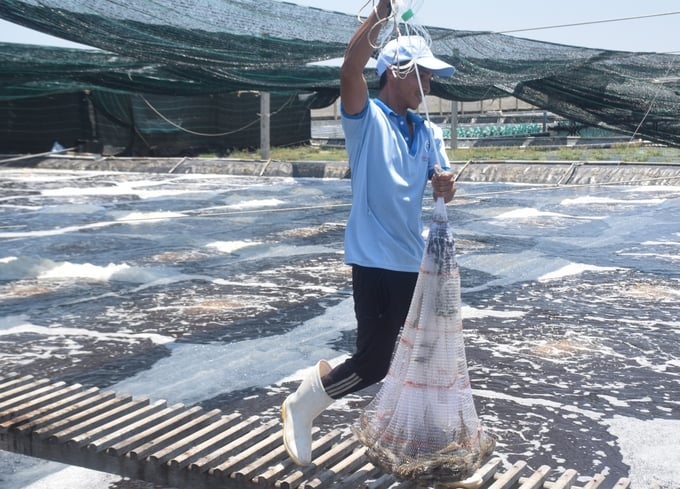
Shrimp prices are currently on a rising trend, allowing farmers to secure profits. Photo: V.D.T.
As we travel through the shrimp farming areas in Hoai Nhon Town, Binh Dinh Province, we are greeted by the bright smiles of shrimp farmers and the busy atmosphere of preparations for the upcoming shrimp crop. Local farmers revealed that the price of commercial shrimp has recently seen a sharp increase. During the second 2024 harvest, many shrimp farmers in this area achieved both high yields and favorable prices.
Do Van Dinh, a farmer from Tam Quan Bac Ward, Hoai Nhon Town, Binh Dinh Province, owns two shrimp ponds with a total area of 2,000 square meters, with one measuring 800 square meters and another 1,200 square meters in Tan Thanh quarter. After three and a half months of farming, with shrimp reaching a size of 80 shrimp per kilogram, Dinh harvested a total of three tons of shrimp. One month prior to our conversation, he harvested another batch of shrimp when they reached the size of 30 shrimp per kilogram. In total, Dinh produced nine tons of shrimp during this crop.
The sharp increase in shrimp prices further motivated farmers' confidence in the current crop. The prices for 30 shrimp per kilogram stood at approximately 140,000 VND per kilogram before August. At present, they have climbed to 200,000 VND per kilogram. After deducting investment costs, Dinh earned a net profit of nearly 1 billion VND from his shrimp harvest.
"The sudden increase in shrimp prices has allowed farmers to secure significant profits. After the harvest, I immediately began renovating the ponds in preparation for the next crop, which starts on October 4," Dinh shared.
Similarly, Nguyen Van Tien, a white-leg shrimp farmer from Van Tho Commune, Van Ninh District, Khanh Hoa Province, noted that the price of local large white-leg shrimp saw a sudden increase recently due to limited supply as shrimp farming activities entered the challenging off-season.
Traders are currently paying between 230,000 and 240,000 VND per kilogram for shrimp measuring at 24 shrimp per kilogram. On the other hand, shrimp measuring at 30 shrimp per kilogram currently fetch a price of approximately 200,000 VND per kilogram, which is 30,000 more than two weeks ago. For the past two months, the cost of shrimp measuring at 100 shrimp per kilogram has remained relatively stable at roughly 96,000 VND.
"At present, farmers harvesting large-sized shrimp are enjoying considerable profits. However, with the ncreasingly unpredictable weather patterns, large-sized shrimp farming will become more challenging and require the application of advanced technology," Nguyen Van Tien shared.
According to Le Minh Chinh, Director of Ninh Phu Aquaculture Cooperative (Ninh Hoa Town, Khanh Hoa Province), local farmers in Ninh Phu Commune have seen significant profits due to the high prices for large-sized shrimp. Additionally, the shortage of raw shrimp forced traders to lower their requirements regarding shrimp color.

As shrimp prices rise rapidly, farmers in the South Central region eagerly prepare for off-season farming. Photo: K.S.
"During the first harvest this year, my family produced between 5 and 7 tons of shrimp per 1,600 square meter pond. However, we made little profit because we sold our harvest when prices dropped to 110,000 VND per kilogram (30 shrimp per kilogram)," shared Le Minh Chinh.
Ninh Phu Aquaculture Cooperative has harvested two shrimp crops since the beginning of 2024, with a total yield of over 150 tons. Notably, Chinh’s family harvested nearly 100 tons and earned close to 2 billion VND after deducting costs.
In 2024, Binh Dinh Province plans to farm white-leg shrimp over an area of 2,000 hectares. According to the crop schedule issued by Binh Dinh's agricultural sector, the high-tech intensive farming areas for white-leg shrimp will follow a three-crop annual schedule, with stocking densities ranging from 300 to 500 shrimp per square meter. Accordingly, the first crop will last from early March to the end of May, the second from early July to the end of September, and the third from early November 2024 to late January 2025.
According to Pham Thanh Nhan, Head of Aquaculture at Binh Dinh Province's Sub-Department of Fisheries, the prices for white-leg shrimp in the first crop dropped noticeably, ranging between 80,000 and 90,000 VND per 100 shrimp per kilogram. However, prices jumped significantly in September, prompting farmers to increase their production. So far, the shrimp farming area in Binh Dinh Province has reached over 1,953 hectares, with more than 1,667 hectares stocked in the first crop and nearly 240 hectares in the second crop.
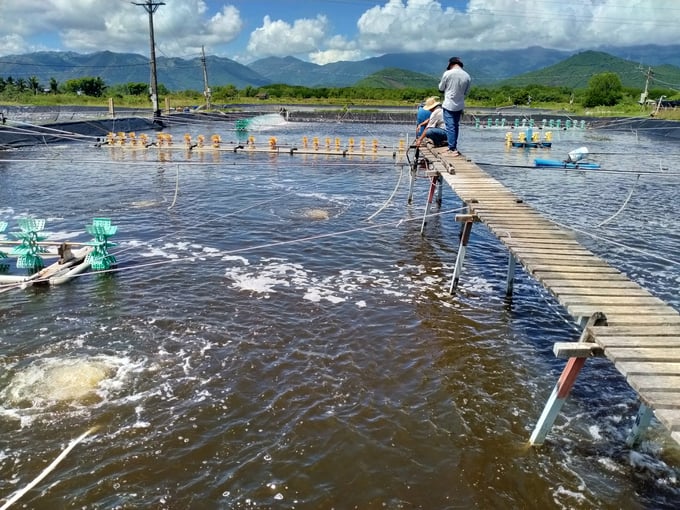
The biggest concern for off-season shrimp farming is the risk of red body disease. Photo: V.D.T.
Mai Thi My Truc is the owner of six shrimp ponds, each covering over 1,000 square meters in Tam Quan Nam Ward (Hoai Nhon Town, Binh Dinh Province). Despite the consistently high yields from her ponds over the past two years, Truc reported that her farming activities were unprofitable due to the low prices. During the first crop of 2024, Truc sold her harvest immediately before the price hike. She is currently stocking shrimp in preparation for the upcoming crop. She remarked: “This shrimp crop is particularly challenging. We can expect high prices during the end-of-year holiday season as demand booms due to New Year’s celebrations and parties.”
According to farmer Do Van Dinh, shrimp farmers face an increased risk of red body disease during the stormy season. With appropriate shrimp tending and disease prevention measures, farmers can expect considerable profits from the high market prices.
“Red body disease in shrimp is caused by a virus without a specific treatment. However, farmers can prevent the disease by feeding shrimp antibiotics and maintaining a healthy water environment. The virus is always present in shrimp ponds; however, adverse weather conditions during the stormy season can weaken the shrimp, thereby making them more susceptible to infection,” Dinh explained.
Dinh also noted that farmers must regularly apply probiotics and minerals to maintain water quality and strengthen the shrimp’s resistance to red body disease during off-season farming. “During the stormy season, birds, such as herons, are more active. These birds are a significant factor in spreading disease among shrimp. They feed from infected ponds and then fly to others, potentially spreading the virus to previously unaffected shrimp farms,” Dinh added.
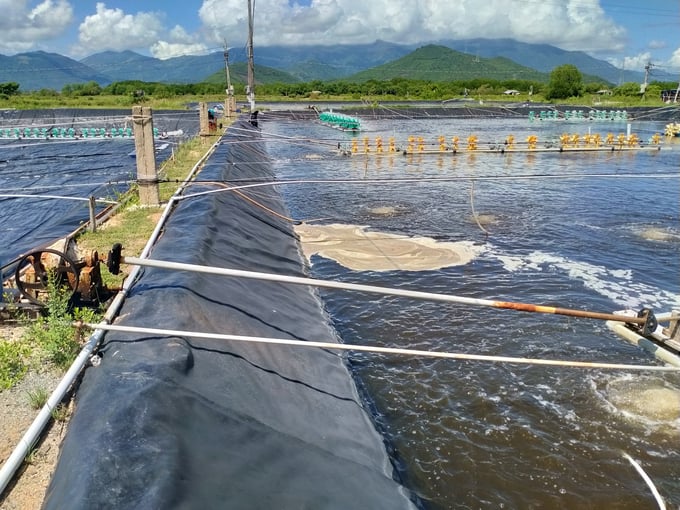
Off-season shrimp farming requires additional tending efforts due to unfavorable weather conditions. Photo: K.S.
According to Pham Thanh Nhan, shrimp farming during the stormy season is considered off-season. Furthermore, only high-tidal areas are suitable for farming as they are less prone to flooding. Due to challenging weather conditions, farmers must follow a strict farming procedure to prevent disease outbreaks. The transition between seasons can cause an immense amount of stress for the shrimp, making disease prevention critical. As the rainy season progresses, shrimp farmers must avoid accumulating excess feed in the ponds and closely monitor water quality to prevent outbreaks of digestive diseases.
“For the second shrimp crop, farmers need to take extra precautions during pond preparation, including eliminating disease-carrying intermediary hosts such as crabs, mud crabs, shrimp, and small fish using approved chemicals. Before stocking shrimp, the pond water must be treated through a system of sedimentation and filtration ponds. Subsequently, farmers should disinfect the water to eliminate viruses, bacteria, spores, and protozoa using chemicals such as formalin, lime (CaO), or chlorine before introducing water into the farming ponds,” advised Huynh Ngoc Diep, General Director of the Binh Dinh Province's Sub-Department of Livestock Production and Animal Health.
Translated by Nguyen Hai Long

(VAN) Japan will release another 200,000 metric tons of rice from its emergency stockpile to tackle a doubling of prices since last year, Agriculture Minister Shinjiro Koizumi said on Tuesday.

(VAN) Coffee prices on June 13 declined sharply for Arabica. Domestic coffee market in Vietnam dropped by VND 2,000, trading at VND 111,500 – 112,300/kg.

(VAN) Coffee prices on June 12, 2025, continued to fall. Domestically, coffee prices decreased by another VND 2,000, trading at VND 111,500 – 112,300/kg.

(VAN) Coffee prices on June 11, 2025, fell sharply across global markets. Domestic coffee market dropped by VND 700, to the range of VND 113,500 – 114,300/kg.
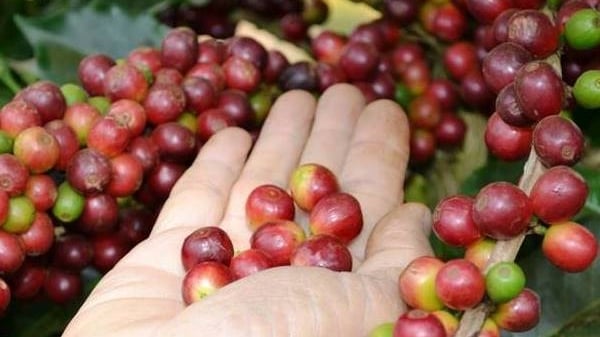
(VAN) Coffee prices on June 10 2025, rose sharply worldwide for Robusta. Domestic coffee market increased by VND 800, reaching VND 114,200 – 114,800/kg.
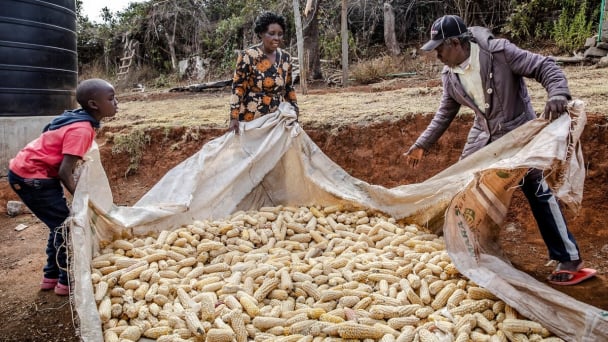
(VAN) New FAO forecasts point to record global cereal output with a partial rebound in stocks and trade.
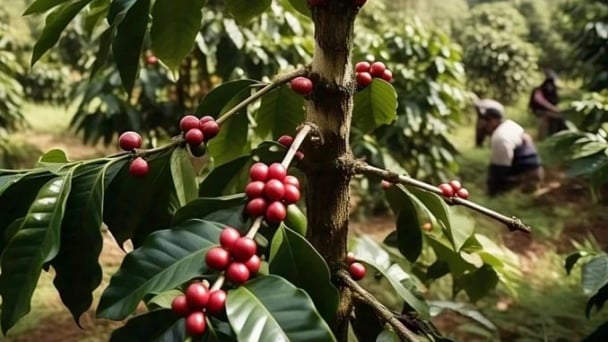
(VAN) Coffee prices on June 9, 2025, in domestic and global markets remain unchanged. Domestic coffee market is currently trading at VND 113,500 – 114,000/kg.